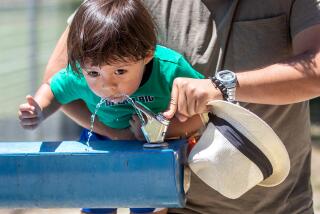A Cooling Treatment for Newborns
WASHINGTON — Most pediatricians who take care of newborns sooner or later confront this tragedy: a perfectly formed, full-term baby emerges after a difficult labor, but develops severe seizures and signs of permanent neurological damage because the brain didn’t receive enough oxygen-rich blood at some point during birth.
Even with good obstetrical care, this kind of brain injury occurs in an estimated 12,000 full-term infants in the United States each year, and in a larger number of premature babies. With current treatments, doctors are powerless to prevent or mitigate the resulting death of brain cells, which seems to occur inexorably over hours or days after the birth and often produces mental retardation or cerebral palsy.
Now, an old idea--cooling the baby down--has been revived as a promising therapy to reduce the extent of brain damage. Animal studies, performed in newborns or fetuses of several different species, show persuasively that mild cooling, for up to 72 hours, can dramatically reduce the number of nerve cells that die after circulation to the brain has been temporarily cut off. In humans, mild cooling means reducing core body temperature to a range of 93 to about 96.8 degrees.
Recently, a New Zealand pediatrician reported results from the first trial of a special “cooling cap,” tested as a way of selectively cooling the head in full-term infants who showed signs of oxygen deprivation before birth. Her findings from a small comparative study of 22 infants--reported at an international conference in Washington--suggest that the treatment is safe and, in her view, ready to be tested in a larger international trial.
“There should be a multicenter study,” said Tania Gunn, an associate professor of pediatrics at Auckland University Medical School who tested the cap extensively in fetal sheep before trying it on human infants. “I’m into caution.” She said cooling of brain-injured infants should be thoroughly studied in further trials rather than “people rushing out and doing whole-baby cooling, willy-nilly.”
Other experts at the recent meeting said the evidence from animal studies is exciting and provocative, but they added that doctors will have to proceed very carefully as they evaluate a treatment that runs counter to established standards of newborn care. Since 1958, when a landmark study found that lowering the temperature increased the death rate in premature infants, the dogma in hospital nurseries has been: Warm up babies immediately after birth and keep them warm.
“It’s become the absolute orthodoxy,” said John S. Wyatt, a professor of neonatal pediatrics at University College in London. “We wrap the babies up, put hats on their heads, spend a great deal of effort.”
But researchers have found that babies born outside hospitals, as most humans were until this century, normally drop their body temperatures to 95 degrees or lower just after birth and then warm up again gradually over the next several hours, Wyatt said. That could be a physiologic strategy that evolved to protect the human brain against the belated ill effects of any oxygen deprivation that might have occurred during labor, he suggested.
“I’m developing this heresy that babies may be designed to go cold,” Wyatt said.
Wyatt, Gunn and others emphasized that hypothermia--an abnormally low body temperature--has recognized medical risks for babies, especially for premature infants. It reduces the heart’s ability to pump and can produce abnormal heart rhythms. It makes blood thicker and can decrease circulation to the kidneys and intestinal tract. It makes the baby breathe rapidly, suppresses the immune system and can lead to bleeding, including lung hemorrhages. And it is a total-body stress, forcing the baby to shiver and generate heat metabolically to keep warm.
Nonetheless, cold has been advocated as a desperate treatment for near-dead newborns since 1697, when Sir John Floyer described seeing a young doctor plunge an apparently stillborn infant into a tub of ice, from which the child emerged screaming lustily. In the 1950s and ‘60s, researchers in Sweden published reports of more than 75 babies, born unresponsive after severe oxygen deprivation, who were immersed in cold water and cooled to core body temperatures as low as 80 degrees, then very slowly rewarmed. Most survived and showed no evidence of cerebral palsy, an impairment of muscle strength and coordination that commonly develops after such brain injuries.
However, a 1958 study by pediatrician William Silverman persuaded doctors that cold was dangerous for infants. He randomly assigned premature babies to incubators with either of two air temperatures: 84 degrees and 89 degrees. Survival was 83% in the warmer incubators, 68% in the cooler ones. Although most of the difference in death rates was seen in infants weighing less than 2.2 pounds, the conclusions were applied to all newborns. The study “sounded the death knell for hypothermia,” Wyatt wrote in a recent commentary.
But for an infant brain that has suffered a period of hypoxia--insufficient oxygen because of a reduced blood supply--a large body of evidence now indicates that cold can be protective. After an episode of hypoxia, animal studies show that energy use by brain cells initially returns to normal, but then declines over about 48 hours, Wyatt said. Damage occurs gradually as “excitatory” chemicals build up inside cells and trigger an array of changes, ultimately causing some nerve cells to die.
Studies by Wyatt, Gunn and other researchers in newborn piglets, rats and fetal sheep found that reducing brain temperature by about four to 11 degrees for up to 72 hours could reduce the number of cells that died by about half. To be effective, cooling had to begin within a few hours of the brain injury, and researchers don’t know precisely what degree of cooling--or what duration--would be optimal for a human infant.
Jerold F. Lucey, a professor of neonatology at the University of Vermont and editor of the journal Pediatrics, called the results of cooling in animal studies “spectacular.” He said he favors larger studies of the treatment. But pediatricians at the conference warned that conducting a trial in full-term infants with hypoxic brain injuries will be an enormous challenge. Even the country’s busiest hospitals may deliver only a dozen such infants each year, and identifying the babies early enough to start the treatment promptly after birth will be difficult.
Michael V. Johnston of Johns Hopkins University School of Medicine predicted that the technique’s chief value may be in prolonging the period during which additional measures, including experimental drugs, can help to protect brain cells after an injury. Several drugs have been tested, but the results suggest they have to be given before the injury or immediately afterward.
“With . . . mild hypothermia, we might be able to extend the window for many of these drugs,” he said.





